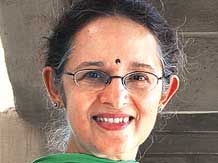'The rate cuts should, however, be very gradual to continue the focus on inflation expectations.'
 Bank credit growth, still sluggish, could see a rise if the Reserve Bank of India decides to cut interest rates, believes Ashima Goyal, an external member of the central bank's technical advisory committee and professor of economics at Indira Gandhi Institute for Development Research, Mumbai.
Bank credit growth, still sluggish, could see a rise if the Reserve Bank of India decides to cut interest rates, believes Ashima Goyal, an external member of the central bank's technical advisory committee and professor of economics at Indira Gandhi Institute for Development Research, Mumbai.
In an interview with Business Standard, she discusses a range of issues on the economy. Edited excerpts:
Do you think there will be some upturn in inflation once the base effect vanishes?
The glide path for retail inflation is eight per cent by January 2015 and six per cent by January 2016.
That is RBI’s target. Formal inflation targeting is not there, it is being discussed with the government.
However, the economy is over-achieving on the glide path. RBI’s own March (2015) forecast has come down to six per cent.
Because of this, there is some room to cut rates.
Inflation has come down because of the reduction in oil and other commodity prices.
Even if there is some upturn due to the base effect, it will not be large enough to raise inflation above six per cent. There is very little risk to the latter target.
Is RBI likely to defer interest rate cuts due to volatility in the currency?
I do not think it should do so in the Indian context, for a number of reasons.
We have had some real appreciation in the rupee in the past, due to which we can take some depreciation.
RBI is comfortable with the foreign exchange reserves, and inflows are also large enough to protect against any severe depreciation.
So, I do not think rupee depreciation will be sufficiently large to require any interest rate defence.
This is aimed at retaining debt inflows.
Our experience of 2013 is when RBI raised short-term interest rates by 300 basis points, it did not work much because even after four or five months, debt outflows continued.
So, it is better to focus on the domestic cycle.
Higher growth will attract better quality inflows. More, debt inflows are still capped, although these caps have been relaxed.

When do you expect the rate cut cycle to begin?
The RBI governor will decide. I will not predict what will happen, but my view is that RBI should already have started cutting rates.
The aim of a glide path is to reduce the output sacrifice of disinflation.
If the trend of inflation is already under the glide path, output is much below potential and industry is hardly growing, it is possible to think of stimulating demand.
Household inflation expectations are most affected by food inflation.
That should come down because internationally, too, food prices are softening. If all this is helping to anchor inflation, you can reduce interest rates.
The rate cuts should, however, be very gradual to continue the focus on inflation expectations.
The path should be data-dependent. Steep cuts had occurred when oil prices fell in 2008 and led to over-stimulus.
This should be avoided.
The rate cut cycle should have begun in October, maybe by a 25 basis points cut. The cycle could have started.
Then, there is no need to cut every time, as the signal itself and future expected cuts have a positive impact.
Probably, RBI is waiting to see what happens after the base effect wears out.
Do you think concern on the current account deficit might be back in 2015, as gold imports have risen? Was it prudent to remove the 80:20 restriction on gold import?
The CAD is not seen much above two per cent of gross domestic product, as the reduction in oil prices will help.
Some increase in gold imports should taper off in the long term.
If it doesn’t, the government may impose some restrictions.
There is one view that 80:20 kinds of restrictions encourage smuggling.
Unfortunately, the restriction was removed during the festive season, when consumption of gold increases.
What we are hearing is that as prices of gold had fallen, people had stockpiled. Let us see how it works out.
When do you see the US Federal Reserve raising interest rates? Are we going to be vulnerable?
They will do so in the course of next year but it will be a very slow approach.
I think they will learn from the (earlier) tapering episode and not surprise the market.
Their domestic economy is doing much better, so, they are ready for some kind of normalisation.
I think the steps India has taken in the past year has made it one of the least vulnerable markets.
The US Fed will go very carefully.
Even if global markets are in trouble, we should not see so much of outflow, as we have much better growth prospects.
What is causing the fall in foreign exchange reserves? Will the rupee depreciation make it worse?
The fall in RBI's foreign exchange reserve is due to valuation effects, as the dollar is strengthening, not due to any large outflow or intervention.
It is a problem that companies have not hedged their foreign exposures.
Due to that, some volatility in the rupee is good because it reminds firms of the need to hedge.
You now see a lot of firms coming forward to do so.
Will we see a slowing in foreign flows over 2015?
The US quantitative easing is over but that in Japan and by the European Central Bank has continued.
So, there is still a lot of global liquidity.
Continuing inflows depend on whether India delivers on higher growth, along with macro economic stability.
But over a longer period of time, there should not be over-dependence on foreign flows.
We need to increase our own manufacturing capabilities and raise domestic savings.
A sustainable CAD is one to two per cent of GDP and that much of inflow should not be a problem.
The government’s moves should attract more foreign direct investment, which is a better quality and more stable type of inflow.
In the absence of a rate cut, what will happen to GDP growth?
Agriculture has helped sustain growth but industry and services are not doing very well.
On some aspects we seem to have bottomed out and so are climbing out from the sub-five per cent we had reached. I think GDP growth should be at least five per cent.
Which five key factors will impact domestic markets?
Impact of the US rate cuts reversal, size of growth in emerging markets like India and China, the slowdown in Europe and Japan, softer oil prices and possible coordination across central banks to minimise global shocks and spillovers.
Bank credit continues to be sluggish. Do you think we need rate cuts to drive it?
Some reduction in interest rates would help. In the present rate structure, deposit growth is higher than loan growth.
This shows banks are flush with funds, implying the price of credit needs to adjust.
But easier restructuring, as has been allowed for at least large projects, will also help.
Infrastructure needs long-term loans and what banks are allowed are short-term loans.
This leads to some mismatch.
Reviving demand and improving the ease of doing business will also help credit growth.













 © 2025
© 2025